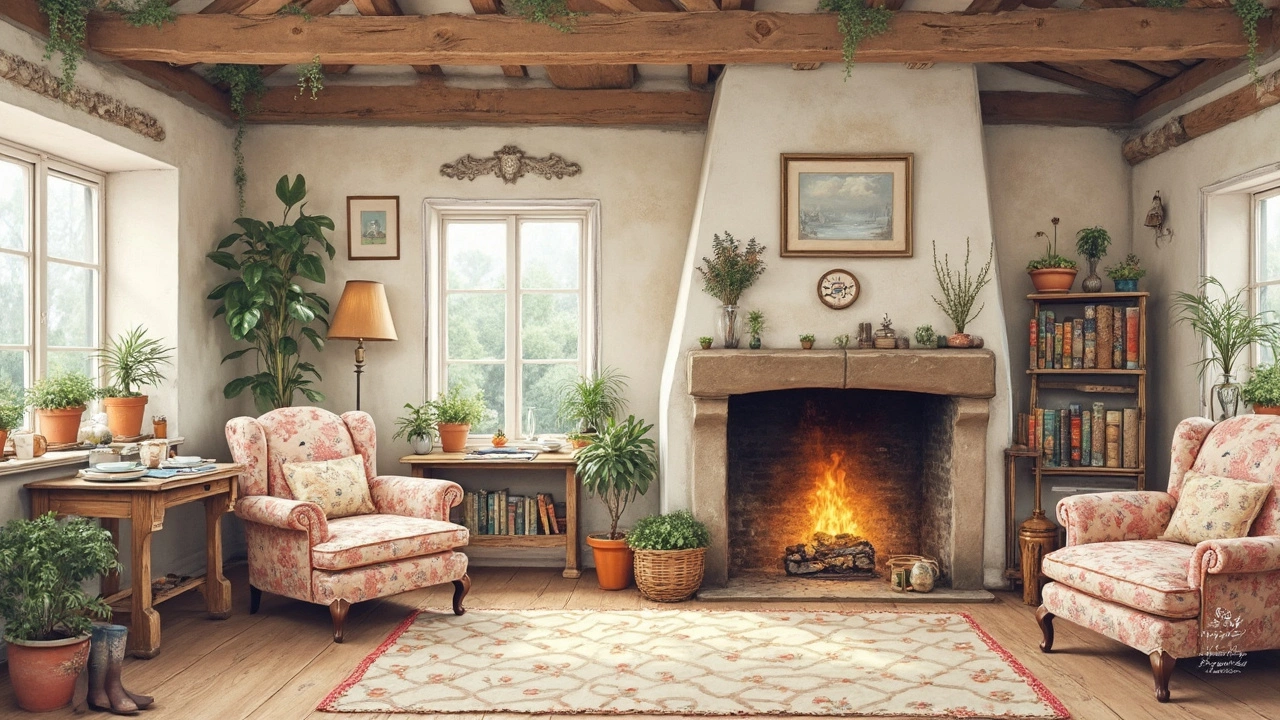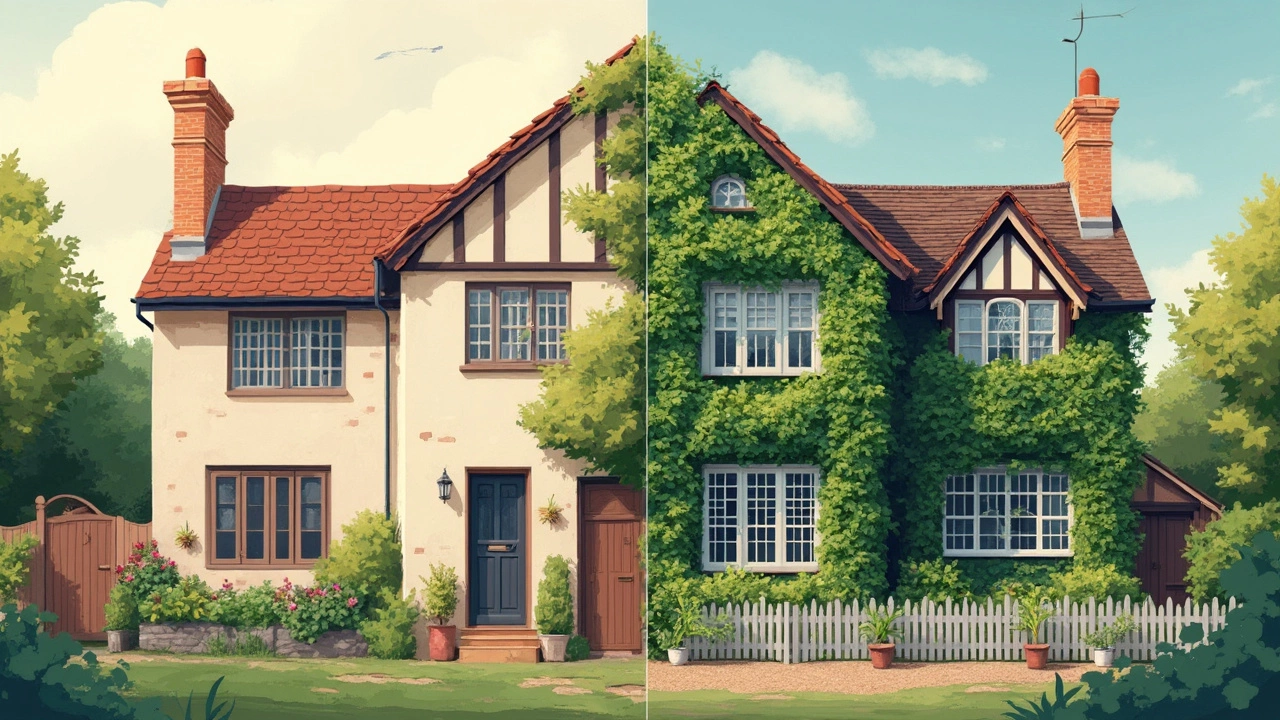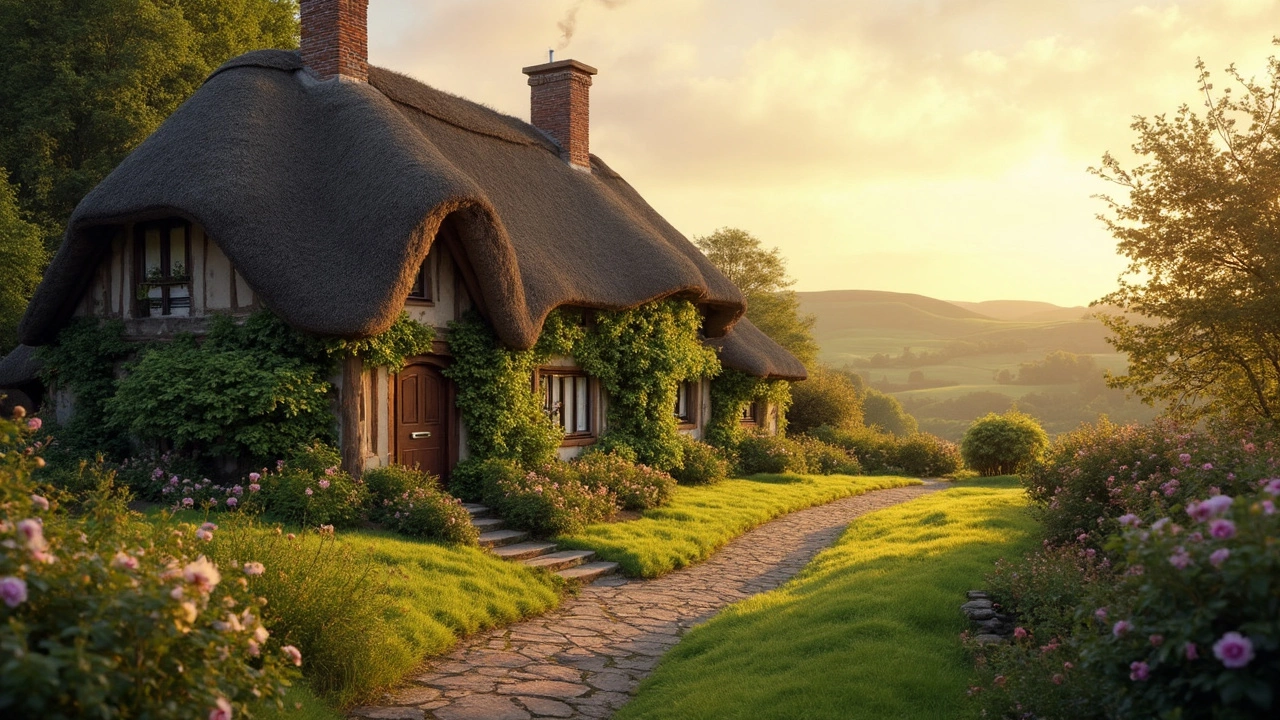Not every small house in the countryside is a cottage. Ever seen a quaint place and wondered if it really counts, or if it's just tiny and old? There's more to it than size or a thatched roof. True cottages have a mix of features that give them a different vibe than, say, a suburban ranch or an urban townhouse.
Cottages usually come with a story. Most sit in a rural setting or at least look like they belong in one, even if they're in the middle of town these days. They give off a cozy feel, thanks to their simple layout, practical design, and those little touches—like a front porch, exposed beams, or a wild garden out front. These details aren't just Pinterest trends; they're grounded in the way people lived hundreds of years ago, making every inch count and keeping things comfortable.
If you're dreaming about cottage life or just want to bring that charm home, knowing what counts (and what doesn't) is a big help. You don't need acres of rolling land or a stone well. It's about smart use of space, welcoming details, and a connection to your surroundings. Wondering what else turns an ordinary home into a real-deal cottage? The real answer might surprise you.
- Where Cottages Came From
- Core Features That Define a Cottage
- Cottage Style vs. Other Home Types
- How to Add Cottage Charm Anywhere
- Debunking Common Cottage Myths
Where Cottages Came From
Ever wondered who started living in cottages first? The roots of the cottage go way back to the Middle Ages in England. Back then, "cottagers" were workers who lived on farms. They had a small patch of land and a simple home. It wasn't fancy—usually just two rooms, a kitchen hearth for heat, and maybe some animals out back. The main thing was practicality. It had to be easy to keep warm, easy to take care of, and close to the fields for work.
The word “cottage” comes from the old English “cot” meaning a small house. In the 1400s, people didn’t use the word like we do now. It just meant you were someone with a small house in the country and not much else. But as time rolled on, especially in the 1800s during the Industrial Revolution, cottages started looking a bit different. Wealthier folks began building "picturesque" cottages as retreats, with more details and fancier gardens. Still, the core idea stuck: a humble home, built for comfort.
Different countries have their own twist. In Ireland, cottages often have whitewashed walls and a thatched roof. In France, you get those cute stone “maisons de campagne.” In the U.S., the look got mixed up with beach and lake houses, but the principle stayed the same—down-to-earth, practical, and homey.
Let’s look at some numbers. In England alone, over 200,000 traditional cottages are still standing today, mostly in rural areas. Many have heritage protections because people want to hang onto that classic countryside charm.
| Country | Common Cottage Materials | Historic Features |
|---|---|---|
| England | Stone, brick, timber | Thatched roof, low ceilings |
| Ireland | Whitewashed stone | Thatched roof, single story |
| France | Limestone, wood | Shutters, steep roof |
| United States | Wood, shingles | Porches, clapboard siding |
So, when you think about a cottage today, it’s really this mix of practicality, history, and that certain cozy feeling that people have chased for centuries. It’s not about size or price. It’s about roots, location, and how the place feels inside and out.
Core Features That Define a Cottage
There's no official cottage rulebook, but real cottages almost always share some solid basics. They’re usually on the small side—most are under 1,500 square feet, with some classic country cottages falling below 1,000. It’s more about being practical than cramped; every room has a purpose, and there’s not a lot of wasted space.
Another tell-tale clue is materials. Cottages are often built with what's nearby: stone in one region, brick or wood in another. You’ll see exposed beams, wood floors, fireplaces, and windows that open wide (who wants stale air, right?). The roof is usually simple—pitched or gabled—sometimes with dormer windows poking out if there's a second floor. The layout skips the fancy stuff. Instead of long hallways and sprawling rooms, expect a compact and cozy setup, with the kitchen often right by the main living area.
The style isn’t just about the building either. Gardens are a big deal. You’ll spot beds of wildflowers, maybe a veggie patch or some berry bushes—all right out front or just out the back door. These outdoor spaces aren’t manicured within an inch of their life; they’re lived-in and a little wild, just like a real cottage garden should be.
- Cottage Size Often Under 1,500 sq ft
- Common Materials: Stone, Wood, Brick
- Simple Rooflines (Pitched or Gabled)
- Open Layouts, Not Much Hallway Space
- Front Porch or Entryway (if possible)
- Natural Connection—Windows Overlooking Greenery
- Casual, Wild-Looking Gardens
For a quick look at what sets a cottage apart, check out this table comparing home styles:
| Feature | Cottage | Suburban House | Farmhouse |
|---|---|---|---|
| Usual Size (sq ft) | 800–1,500 | 1,800–2,700 | 1,600–3,000 |
| Main Material | Stone/Wood/Brick | Vinyl/Brick | Wood/Siding |
| Garden Style | Wild, Small Beds | Lawn with Shrubs | Large, Functional |
| Roof Type | Pitched/Gabled | Varied | Pitched/Gabled |
If you walk into a house with a snug layout, practical rooms, old-school materials, and a garden gone a bit wild, you’re probably in a cottage—no matter where it’s hiding.

Cottage Style vs. Other Home Types
It's easy to lump all small houses together, but a cottage stands out from the rest. While cabins, bungalows, and tiny houses all bring cozy to mind, their designs, purposes, and even locations set them apart from the classic cottage.
Let’s break it down. A true cottage usually comes with a steep-pitched roof, asymmetrical design, and a direct connection between indoor comfort and the outdoors. You’ll often find a deep porch and lots of natural textures like wood or stone. A bungalow is more boxy, with a wide front porch and a single story. Cabins are all about rustic and straightforward living, mostly built with logs or rough timber, perfect for the woods but not always cozy in the same way. Tiny houses, while small, tend to focus on efficiency and may not even have much outdoor space.
Here’s a simple comparison to clear things up:
| Home Type | Usual Size | Common Materials | Outdoor Connection | Typical Setting |
|---|---|---|---|---|
| Cottage | 800–1,500 sq ft | Wood, stone, brick | Yes, gardens/porches | Country, village, sometimes urban |
| Bungalow | 1,000–1,800 sq ft | Wood, brick, stucco | Covered porch | Suburban, some rural |
| Cabin | 500–1,200 sq ft | Logs, rough wood | Decks, not always landscaped | Woods, lakes |
| Tiny House | 100–400 sq ft | Various, often lightweight | Minimal, often mobile | Anywhere, mobile |
Another big difference is the feeling. Cottages are about relaxed, lived-in charm—think mix-and-match furniture and homey kitchens, not stiff formality. Open shelving, soft colors, and hand-me-downs are welcome here. On the outside, you'll see flower beds or vegetable patches squeezed into every available nook, unlike many regular houses with plain lawns.
If you’re thinking about turning your home into a cottage-style retreat, start with adding a porch if you've got the space, or introduce natural materials. Skip the perfectly matched furniture and go for something personal. And don’t ignore your outdoor area—a cottage isn’t complete without a touch of wild, like climbing roses or herbs within arm’s reach.
How to Add Cottage Charm Anywhere
You don’t need an actual rural address or a 200-year-old house to get that cottage feeling. Most of the classic cottage look comes from stuff you can actually control: simple materials, personal touches, and a relaxed style. Whether you rent a city apartment or have a new build in the suburbs, these tricks work just about anywhere.
- Natural materials: Cottages are all about wood, stone, and things that look like they came from the earth, not a showroom. Go for exposed beams, wooden shelving, or just a reclaimed wood table to anchor your living space.
- Soft, layered textiles: Think chunky knit throws, cotton slipcovers, and linen curtains. Even tossing a few pillows in faded florals or checks will do the job.
- Personal collections: Show off handmade mugs, weathered baskets, or vintage teapots. Cottages never look like someone bought everything at once; it’s the mix that matters.
- Wild or cottage-style gardens: If you’ve got outdoor space, skip perfect hedges. Go for plants like lavender, hollyhocks, foxgloves, or herbs. On a balcony, pots of rosemary and daisies pull their weight.
- Practical spaces: Cottages always make small footprints work. Use hooks near doors for jackets, open shelves in the kitchen, or a bench with baskets for muddy shoes. It’s both handy and on-theme.
If you want proof that this style can work just about anywhere, check out this blend of features in actual homes:
| Home Type | Typical Cottage Feature | How to Recreate |
|---|---|---|
| Urban Apartment | Layered textiles & window boxes | Add throw blankets and potted herbs |
| New Suburban House | Covered porch with simple furniture | Install a porch swing and grow climbing roses |
| Small Town Bungalow | Open shelves with dishes & vintage finds | Use display shelves in the kitchen for pottery and cookbooks |
Remember, it’s less about copying a magazine and more about embracing imperfection. The cottage vibe is about comfort, warmth, and making a space feel loved and lived-in—not just styled for a photo. Think about your own habits and add things you’ll actually use, like a big mug for morning coffee or a sturdy doormat for muddy boots. That’s the real heart of cottage living—wherever you are.

Debunking Common Cottage Myths
A lot of people have some pretty fixed ideas about what makes a real cottage, but most of these are off base. Let’s break down some of the biggest myths.
- Myth #1: All cottages are tiny. Sure, they’re not mansions, but there’s no hard-and-fast rule about square footage. Some famous English cottages can run up to 1,500 square feet or more. What counts is how the space feels—cozy and simple—rather than how big it is.
- Myth #2: You need a remote, wild setting. Cottages started as rural homes for workers, but plenty sit in villages or even towns today. The vibe matters more than the GPS coordinates.
- Myth #3: There’s only one look for a cottage. Thatched roofs and stone walls aren’t required. Around the world, cottages can be brick, wood, stucco, or a mix. Think Norwegian log cabins, Irish stone dwellings, or American clapboard farm cottages.
- Myth #4: Cottages are drafty and old-fashioned. You can absolutely have modern insulation, efficient windows, and smart tech in a cottage. People combine new comforts with old-school charm all the time.
- Myth #5: Cottage gardens must be wild and overgrown. The classic look is loose and natural, but you don’t have to let things go wild. Plenty of folks keep neat veggie beds or a simple lawn out front.
For a closer look at what makes a cottage style different from other homes, check out this comparison:
| Feature | Cottage | Suburban House |
|---|---|---|
| Average Size (sq ft) | 800 – 1,500 | 1,500 – 2,500 |
| Materials | Wood, stone, brick, mixed | Vinyl, brick, stone veneer |
| Setting | Country, village, small town | Suburbs |
| Garden Style | Natural, cottagey, sometimes neat | Neat lawn, minimal beds |
| Design Focus | Comfort, function, charm | Space, function, curb appeal |
One more thing: People love using the term "cottagecore" lately for anything cute and rural on Instagram, but the real thing is more than doilies and flower crowns. It’s about intentional, simple living in a space that makes you feel at home—whatever materials, size, or wifi speed you’ve got.
